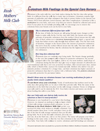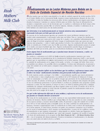Improving the use of human milk during and after the NICU stay
- PMID: 20363457
- PMCID: PMC2859690
- DOI: 10.1016/j.clp.2010.01.013
Improving the use of human milk during and after the NICU stay
Abstract
The feeding of human milk (milk from the infant's own mother; excluding donor milk) during the newborn intensive care unit (NICU) stay reduces the risk of costly and handicapping morbidities in premature infants. The mechanisms by which human milk provides this protection are varied and synergistic, and appear to change over the course of the NICU stay. The fact that these mechanisms include specific human milk components that are not present in the milk of other mammals means that human milk from the infant's mother cannot be replaced by commercial infant or donor human milk, and the feeding of human milk should be a NICU priority. Recent evidence suggests that the impact of human milk on improving infant health outcomes and reducing the risk of prematurity-specific morbidities is linked to specific critical exposure periods in the post-birth period during which the exclusive use of human milk and the avoidance of commercial formula may be most important. Similarly, there are other periods when high doses, but not necessarily exclusive use of human milk, may be important. This article reviews the concept of "dose and exposure period" for human milk feeding in the NICU to precisely measure and benchmark the amount and timing of human milk use in the NICU. The critical exposure periods when exclusive or high doses of human milk appear to have the greatest impact on specific morbidities are reviewed. Finally, the current best practices for the use of human milk during and after the NICU stay for premature infants are summarized.
Copyright 2010 Elsevier Inc. All rights reserved.
Figures




References
-
- Lucas A, Cole TJ. Breast milk and neonatal necrotising enterocolitis. Lancet. 1990;336(8730 1990 Dec 22–29):1519–1523. - PubMed
-
- El-Mohandes A, Picard M, Simmens S. Human milk utilization in the ICN decreases the incidence of bacterial sepsis [abstract] Pediatr Res. 1995;37:306A.
-
- Hylander MA, Strobino DM, Dhanireddy R. Human milk feedings and infection among very low birth weight infants. Pediatrics. 1998;102(3):E38. - PubMed
-
- Hylander MA, Strobino DM, Pezzullo JC, Dhanireddy R. Association of human milk feedings with a reduction in retinopathy of prematurity among very low birthweight infants. Journal of Perinatology. 2001;21(6):356–362. - PubMed
-
- Schanler RJ, Lau C, Hurst NM, Smith EOB. Randomized trial of donor human milk versus preterm formula as substitutes for mothers' own milk in the feeding of extremely premature infants. Pediatrics. 2005;116(2):400–406. - PubMed
Publication types
MeSH terms
Grants and funding
LinkOut - more resources
Full Text Sources
Other Literature Sources
Medical

